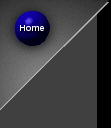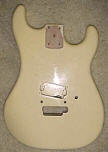 |
Baretta
Details
Here
are some differences in the parts used on Barettas. Please be aware
that Kramer never really settled on a "standard" design for
the body, neck headstock, and neck plate, although they did stay standard
on the Floyd Rose, the one pickup design, and the Schaller tuners.
.
The Banana Headstock Debate
Many newbie Kramer fans are duped into thinking they have a real, non-angled
Banana headstock Baretta, when in fact, they sometimes have overseas
Focus or Striker models. The best way to tell if yours is a real Baretta
neck is if the truss rod adjustment is at the heel of the neck, not
on the headstock. However, this rule only applies to non-angled headstocks,
angled headstocks have the adjustment on the headstock.
| |
|
Do
these headstocks look the same to you? If they do, you're not
looking close enough. The first picture (going left to right)
is the standard 1984 non-angled hockey-stick neck. The "point"
of the headstock is a little larger on the end. This one is found
on most 1984 Barettas "non-tilts" that wind up being
for sale.
The second picture is the headstock from the Kramer "no bozos"
ad. Notce how this headstock is more rounded, and resembles more
of the angled, banana headstock. I have yet to see this headstock
on any other non-angled headstock Baretta.
The third is a rare and what I think to be a prototype shape.
This is my neck, I bought this one through ebay in 2001. This
neck resembles Eddie's
Red "cloud" Ripley and I have seen a few
others with this shape. One other thing to note, I've noticed
this neck show up on later "C" serials after the angled
headstocks began.
As
far as logos are concerned, Barettas had a variety of different
logos on the banana headstock line. The 84' non-tilts had the
older Kramer style logo with the big K. The more common angled
banana headstocks typically had the block logo. Occasionally,
you'll see an block logo with a "Baretta" written after
the Kramer text.
Necks with "Baretta series" under the Block logo were
made by Lasido, a Canadian company. |
Body
Differences
There are loads of Barettas on ebay claiming to be "authentic".
I've found that about 70% of all posted Barettas on Ebay to be truly
authentic. Most of the time, I can tell by looking at the body as to
whether or not its a true Baretta.
| |
The
Baretta Input Jack
A true Baretta does not have a metal plate input jack. Focus 1000
bodies do have this jack, and this is a definite way to tell if
the guitar is truly authentic, or a Baretta "parts" guitar.
This is an example of an authentic Baretta body. |
 |
1984
Baretta Body
84 Bodies can always be spotted by two distinguishing characteristics.
The upper horn on the left hand side differs from the 86 body below.
Additionally, 84 bodies have a cut out at the butt-end of the neck
to access the truss rod. These bodies favor more of the Pacer shape.
If you see a non-angled Baretta neck on anything different than
this body type, it is not an original parts, 84' Baretta. |
 |
1986
Baretta Body
86' bodies are just a tad bit bigger in the lower region. Also,
the left side upper horn is more "pointy" than the 84's.
The tremelo cavity is also a bit larger, although this really does
not make the Floyd float like a recessed route typically does. |
| |
Striker
or F-100 Body - NOT A BARETTA BODY
Beware ebayers, many people will try to pawn these bodies off on
unsuspecting bidders. This is not a Baretta body, and you can tell
by the right horn, it "kicks-out" more to the right than
real Baretta bodies (compare to the other bodies above). Also, the
bottom of the body is more rounded than a Baretta. Beware of these,
these are also made out of PLYWOOD. Even though they look similiar,
they're not worth the time or money given that they will sound horrible. |
Serial
Numbers for Barettas
Here's a breakdown of serial
numbers. If you're Baretta doesn't have a letter before the serial number
that starts with D, E, or F, its either an overseas Focus or Striker,
or its a prototype 1984 Baretta.
C
= 1983-1984 - Banana hockey stick headstock - Non-angled hockeys are
C3000-C5000, angled after that.
D = 1984 - Banana, hockey-stick
E = 1985 - Banana, hockey-stick or Pointy Shark headstock
F = 1986 - Pointy Shark headstock
Other
Details as submitted by Carl Rose, Baretta addict
*
Body - trem route on US models for Floyd smaller than overseas. Floyd
Rose models may have all been screw-in trem arm at this point. Pickup
surround rings unique: angled in a trapezoidal-fashion. Early models
had Schaller HB
pickups (two holes for pickup mounting) while later had SD JBs (single
hole). Volume knob with small "VOLUME" printing. Not sure
of pot #s. Electronics cavity cover screw pattern & neckplate screw
pattern not interchangeable with overseas. Input jacks did not use mounting
plate. (interestingly, my maple-neck model has a black input jack while
the red one uses chrome?). Also think the earliest models (with body-end
neck adjustment) had a smal routing in the neck joint area.
*
Neck - both of mine had R-2 Floyd nuts; Schaller inline tuners with
small attachment to hold allen wrenches. The back of the area where
the neck joins the headstock is smooth on my rosewood and more contoured
on my maple neck. Headstocks *sometimes* painted to match body; if so,
a small line of black visible around
edge of headstock. Neck has "satin"-like finish and is
not bare maple.
|
Website
and Content © Copyright 2011 Infinite Sky Designs |
|



